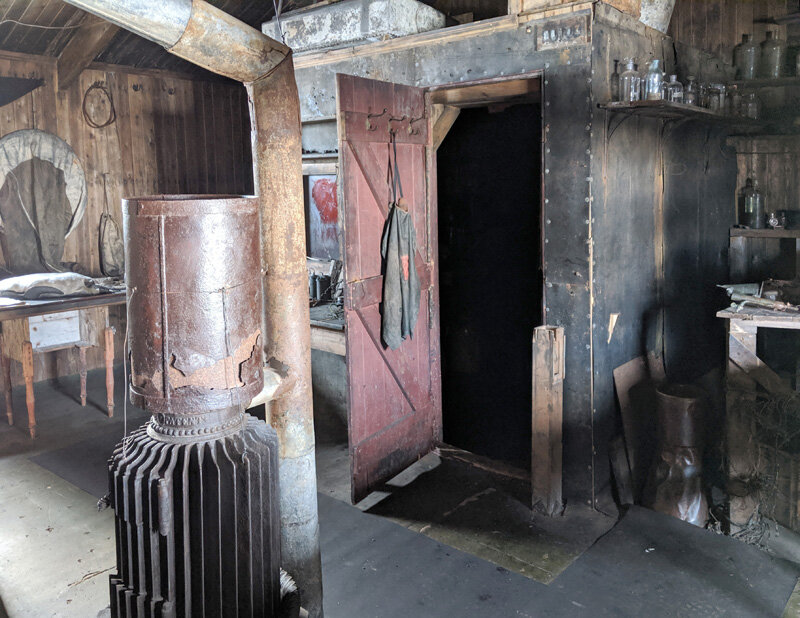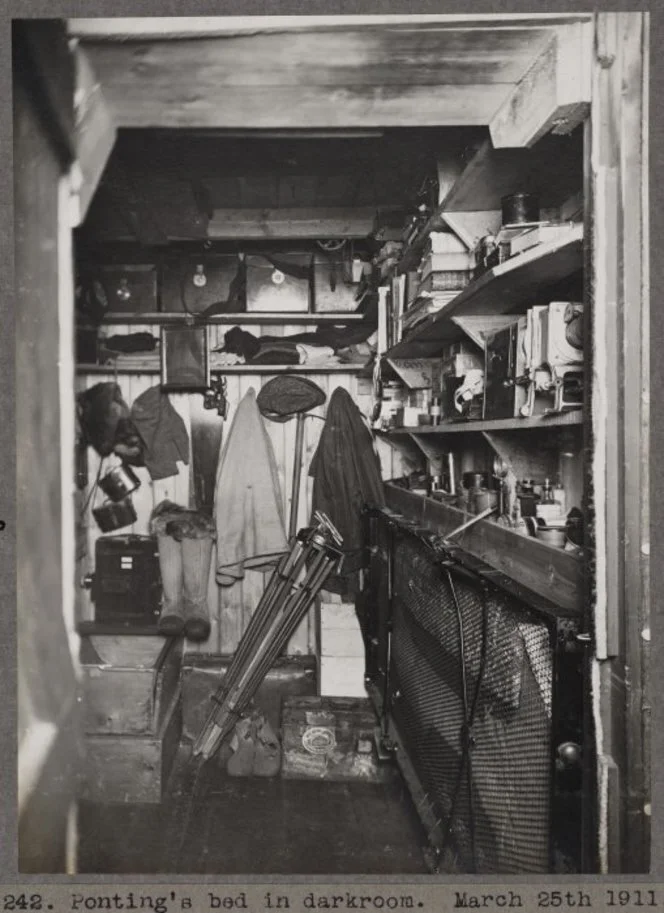Having exited the cosy nook of the executive cabins (which you can just see in the image below, to the left), we are now standing with our back to the rest of the hut, looking at one of the prominent structures built into the interior space: the Darkroom.
Herbert Ponting was a very serious photographer, and was brought along on the Terra Nova Expedition not just to document the science and geography, but to communicate the endeavour in the press back home. He took hundreds of photos and even shot some film – a most precious reference for someone trying to bring the dead back to life. This darkroom was not only his workspace but also his cabin, with a bed that folded up against the wall when not in use, and also served as a classroom where he taught his art to some promising newbies on the crew.
Ponting was only here for one winter. The second winter, Debenham – formerly his student – had taken over as official photographer, but the space was also used for some physics experiments that had been moved in from the outbuilding which had formerly housed them. The weather was so bad that second winter, and the other location so hard to keep a constant temperature, that in order for them to be tended consistently they needed to be in the main hut.
Because heat rises, the roof of the darkroom was not only used for storage, but by the biologists for incubating bacterial cultures. The biologists’ bench is to the right of the image above, so you can see it was a very convenient location.
On the front of the darkroom is a small table which seems to have been used as auxiliary space to the main central table, where most people did their work. It’s covered with mechanical and electric bits now, but from the photographic record I know it was also used as a writing desk and taxidermy bench.
Cherry working on the South Polar Times. The window is here covered with a piece of felt or tarpaper.
The interior of the darkroom is, well, dark. Very dark. This was the best I could manage with the nighttime setting on my phone – it actually shows up a lot more than I could make out with my naked eye, even with very good night vision.
The folding bed was on the right, where the low workbench is now.
The darkroom as it appeared just before a winter of continuous use.
Moving to the port side of the hut, now, we get to the laboratory space. This is another of the secret corners which I most wanted to get a sense of. There are more historical photos of this than Wilson and Evans’ bunks, but I didn’t have a proper sense of how it related to the rest of the hut, and especially to Wright and Simpson’s bunks. Well, stand in front of the door of the darkroom, look to your left, and here it is:
To the right are the bunks in question, which I will get to in short order. Against the far wall is the meteorology lab, dominated by the zinc cylinder of the Dines anemometer, which measured wind gusts and was known in the hut as the Blizzometer. Nearest us is the biology and/or medical bench – it was Atkinson’s domain, anyway, and as such is familiar to me on its own, as this photo has hung above my desk for some time now:
If anyone knows what that contraption is with the conical hood, bent pipes, and brass cylinder, I (and the Antarctic Heritage Trust) would really like to know! It’s on the right side of the historical photo and is lying down on the bench in my modern one. (Atch’s microscope, by the way, is now in Dundee at Discovery Point.)
Now, the bunks! As you can see, unlike the other bunks they run parallel to the wardroom, rather than end-on. While Scott’s men were here they would have been hidden behind the pianola and whatever was stacked on top of it, an arrangement which would have given Wright and Simpson an almost private cubicle to live in, with a window to boot. The pianola was given to Rennick as a wedding present in 1914, and the compact library cabinet which was next to it is now at SPRI, so this corner is much more airy than it would have been when the bunks were occupied.
The window was one of my favourite discoveries. I knew there was a window there, because Nelson’s bench covered in well-lit glassware is possibly the most-photographed location in the hut. What I didn’t know, and wasn’t hinted in anything I’d read or seen, was that you could see the meteorological station on top of Wind Vane Hill from the meteorologist’s bunk.
The official guide says that it’s meteorologist Simpson’s bunk on the bottom, and physicist Wright’s on top. During the second winter Wright discovered that his groggy morning headaches were caused by carbon monoxide from the generator in the lab, whose exhaust vent had got snowed up. I couldn’t see well into the top bunk, but the bottom one has a lovely tableau of personal and meteorological items – those blue arcs are, I think, sunshine recorders.
To get a broader view of the space in this corner and the situation of the bunks within it, here is the view from right next to the window, looking down the length of the hut from the other side of the bunks.
Where we are standing now is at Nelson’s biology bench, the aforementioned most photographed. Because of that, I didn’t take any photos of it myself, but we will see the rest of that side of the hut next time, when we wrap up our tour.












